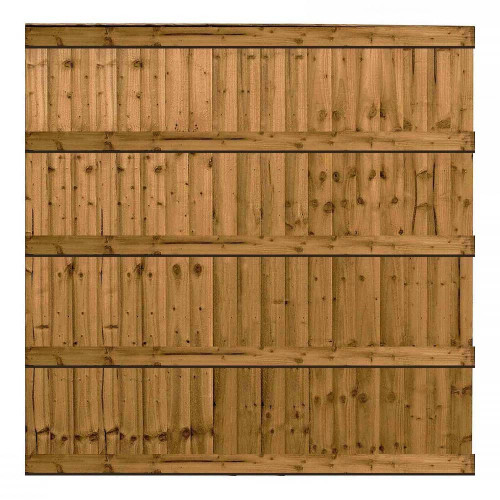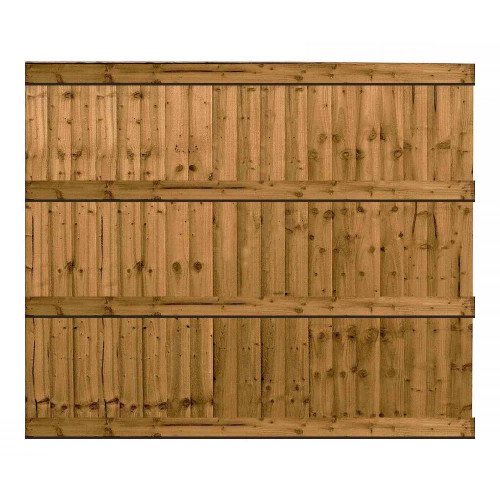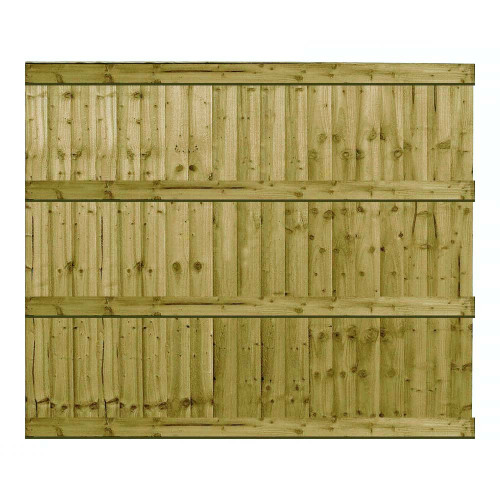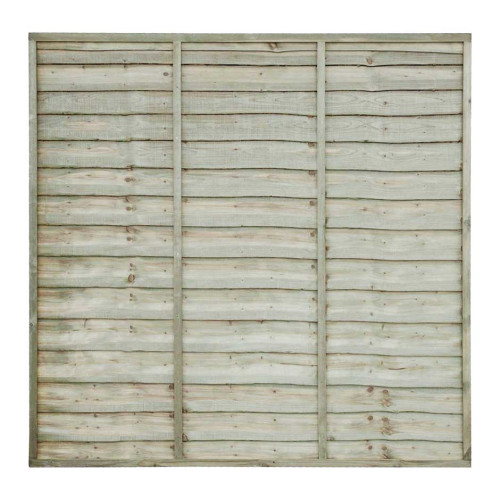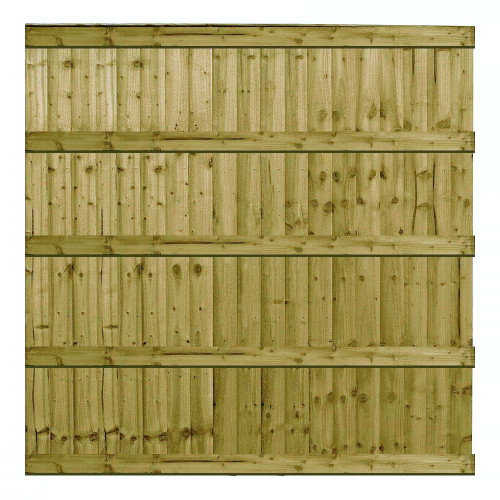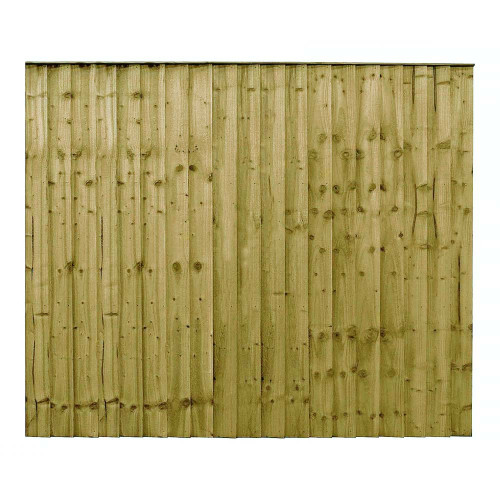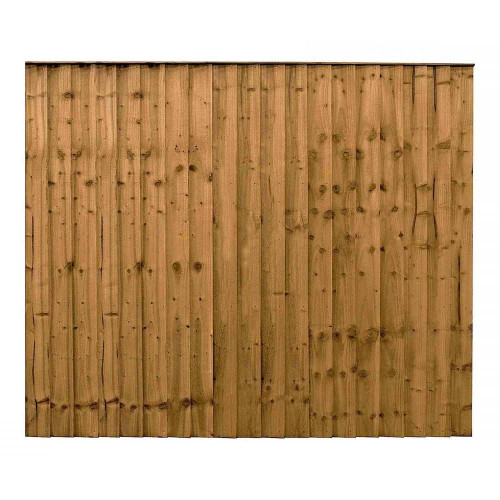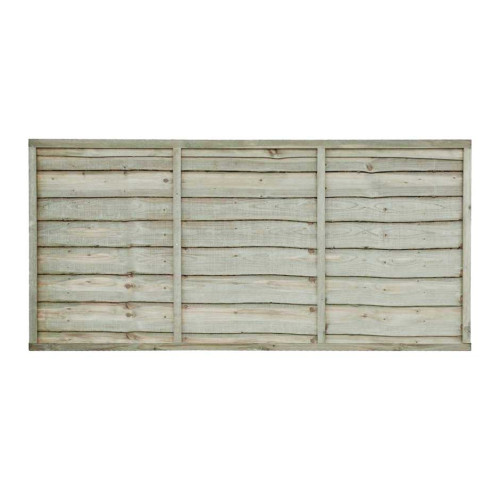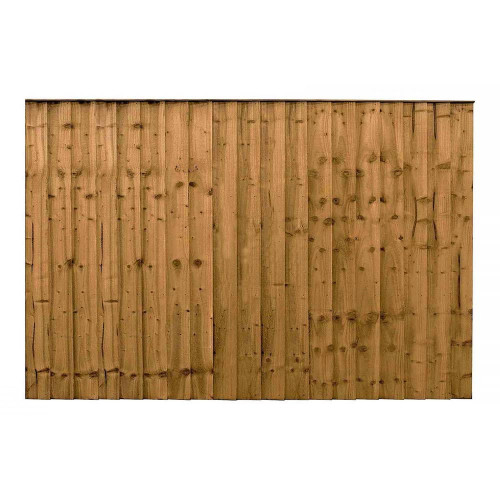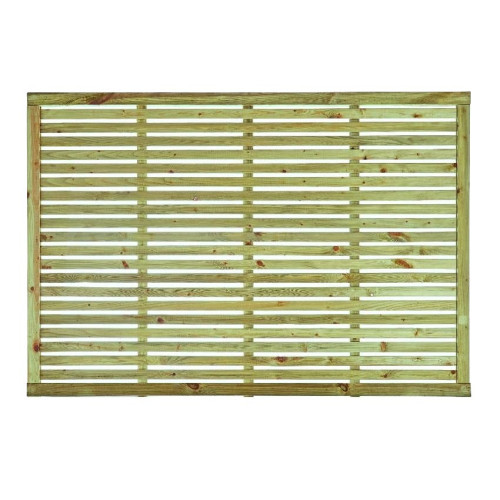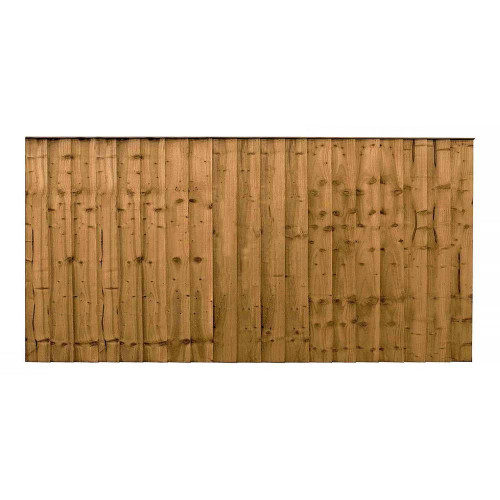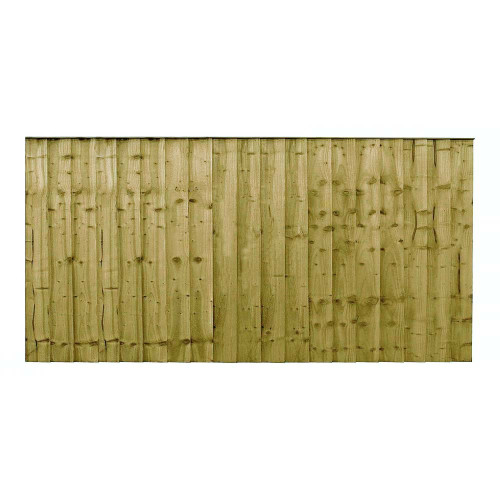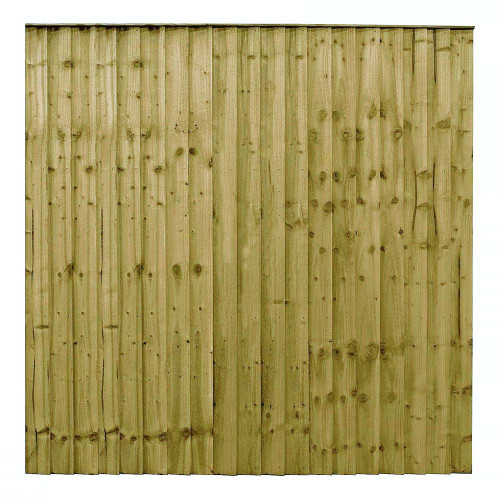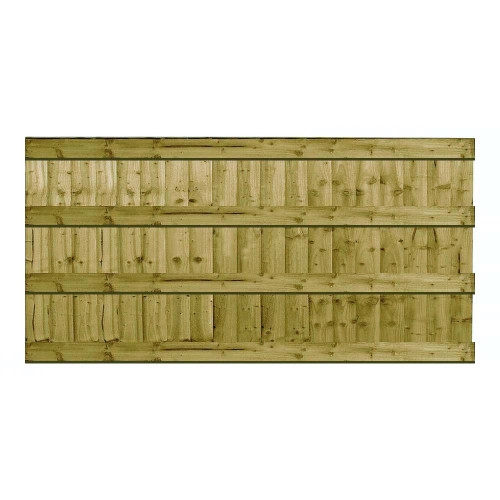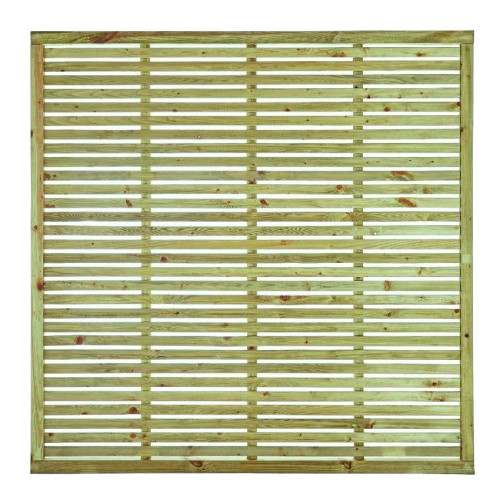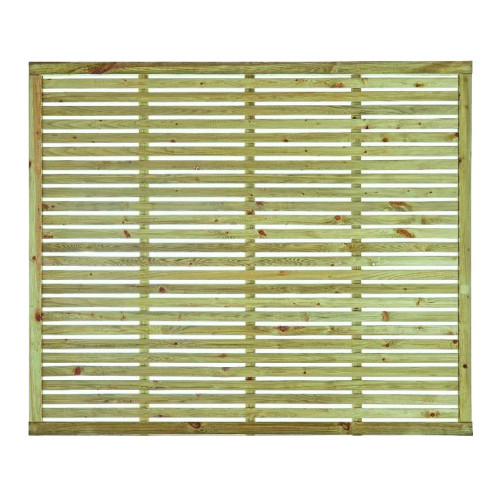The Ultimate Guide to Garden Fencing

If you're looking to buy garden fencing, East Coast Fencing has a wide range on offer. Browse our range of garden fencing today.
Garden fencing is an essential aspect of any landscape. It provides privacy, security, and can enhance the aesthetic appeal of your garden. Whether you're looking to keep pets in, deter intruders, or simply mark your boundaries, choosing the right fence is crucial. This comprehensive guide will walk you through everything you need to know about garden fencing, from the types available to how to maintain them.
Types of Garden Fencing
Garden fencing comes in various styles and materials, each suited for different needs and preferences. Understanding the different types can help you make an informed decision that complements your garden's design and meets your functional requirements.
Wooden Fencing
Wooden fencing is a classic choice for many homeowners due to its natural look and versatility. It can be painted or stained to match your garden's theme and is relatively easy to install. Cedar and pine are popular choices because of their durability. However, wooden fences require regular maintenance to prevent rot and insect damage.
Metal Fencing
Metal fencing, such as wrought iron or aluminium, offers a robust and long-lasting option. It's ideal for those who prioritize security and durability. Metal fences can be ornate or simple, fitting both traditional and modern garden designs. While they typically require less maintenance than wood, they can be prone to rust if not properly treated.
Vinyl Fencing
Vinyl fencing has gained popularity due to its low-maintenance and weather-resistant properties. Available in a variety of styles and colours, vinyl fences are easy to clean and do not require painting or staining. They are also resistant to pests and rot, making them a long-lasting option. However, they can be more expensive upfront compared to wood or metal.
Composite Fencing
Composite fencing is made from a mix of wood fibres and plastic, offering the best of both worlds. It combines the natural look of wood with the low-maintenance benefits of vinyl. Composite fences are resistant to rot, insects, and fading, ensuring they look good for years. They are also eco-friendly, often made from recycled materials. However, they can be more expensive than traditional wood or vinyl options.
5 Biggest Garden Fencing Manufacturers in the UK
The UK is home to several leading garden fencing manufacturers, each offering a range of high-quality products. Here are the five biggest manufacturers you should consider when planning your fencing project.
Jacksons Fencing
Jacksons Fencing is renowned for its high-quality, durable fencing solutions. Established in 1947, the company has a long history of providing innovative fencing products. They offer a wide range of options, including wooden, metal, and vinyl fences. Their products are known for their superior craftsmanship and longevity, making them a popular choice among homeowners and businesses alike.
Grange Fencing
Grange Fencing has been in the industry for over 150 years, providing reliable and stylish fencing options. They offer a variety of materials and styles, ensuring there's something to suit every garden. Known for their innovative designs, Grange Fencing also prioritises sustainability, using responsibly sourced timber and environmentally-friendly practices.
Forest Garden
Forest Garden is a well-known name in the UK fencing market, specialising in timber products. They offer a wide range of garden fencing solutions, from traditional picket fences to contemporary panel designs. Forest Garden is committed to sustainability, using responsibly sourced timber and environmentally-friendly manufacturing processes. Their products are designed to be both functional and visually appealing.
East Coast Fencing
East Coast Fencing is a prominent supplier of garden fencing solutions, well-regarded for their commitment to quality and customer service. Operating along the eastern coastline of the UK, they provide a diverse range of fencing products, including wooden, metal, and composite options tailored to withstand the unique coastal weather conditions. Their selection caters to both practical needs and aesthetic preferences, ensuring that customers can find the ideal fence for their gardens. With a focus on using sustainable materials and environmentally-friendly manufacturing processes, East Coast Fencing not only enhances gardens but also prioritises ecological responsibility.
Birkdale Sales
Birkdale Sales is a leading distributor of fencing and gate products in the UK. They offer a comprehensive range of fencing options, including traditional wooden fences, modern metal designs, and low-maintenance vinyl solutions. Birkdale is known for their commitment to quality and customer satisfaction, providing durable and aesthetically pleasing fencing options.
How to Choose the Right Garden Fencing
Choosing the right garden fencing involves considering several factors to ensure it meets your needs and complements your garden design. Here are some key considerations to help you make the best choice.
Consider Your Needs
Before selecting a fence, think about what you need it for. Are you looking for privacy, security, or simply to add aesthetic appeal? If privacy is your primary concern, taller fences with minimal gaps are ideal. For security, robust materials like metal or composite are recommended. For decorative purposes, picket fences or ornamental designs might be more suitable.
Evaluate Materials
Different materials offer different benefits and drawbacks. Wooden fences provide a natural look but require regular maintenance. Metal fences are durable and secure but may be prone to rust. Vinyl and composite fences are low-maintenance and long-lasting but can be more expensive. Evaluate the pros and cons of each material to find the best fit for your garden.
Check Local Regulations
Before installing a fence, check local regulations and homeowner association guidelines. There may be restrictions on the height, style, and placement of fences. Ensuring compliance with these regulations can save you from potential fines and the hassle of having to redo your fencing.
Budget Considerations
Consider your budget when choosing a fence. While it's tempting to opt for the cheapest option, investing in a higher-quality fence can save you money in the long run by reducing the need for repairs and replacements. Factor in the cost of installation, maintenance, and any additional features like gates or decorative elements.
Garden Fencing: Installation & Maintenance
Proper installation and maintenance are crucial to ensure your garden fencing remains functional and attractive for years to come. Here are some tips to help you install and maintain your fence effectively.
Preparing for Installation
Before installing your fence, prepare the site by clearing any obstacles and marking the boundary lines. Ensure the ground is level and stable to provide a solid foundation for your fence. It's also a good idea to call a professional utility locator to avoid damaging any underground utilities during installation.
Installing the Fence
Follow the manufacturer's instructions for installing your fence. If you're not confident in your DIY skills, consider hiring a professional to ensure proper installation. Make sure the posts are securely anchored and the panels are evenly spaced. Use high-quality hardware to prevent sagging and ensure the fence remains sturdy.
Regular Maintenance
Regular maintenance is essential to keep your fence in good condition. Wooden fences should be inspected for rot, insect damage, and loose boards. Metal fences should be checked for rust and repainted as needed. Vinyl and composite fences require minimal maintenance but should be cleaned periodically to remove dirt and grime.
Seasonal Care
Different seasons can affect your fence in various ways. In the winter, heavy snow and ice can cause damage, so it's important to remove any buildup promptly. In the summer, prolonged exposure to sunlight can cause fading and warping, so consider applying a protective sealant. Regularly inspect your fence for any signs of wear and address issues promptly to prevent further damage.
Garden Fencing: Latest Trends
Keeping up with the latest trends in garden fencing can help you choose a design that is both stylish and functional. Here are some of the current trends in garden fencing.
Sustainable Materials
With growing environmental awareness, sustainable materials are becoming increasingly popular in garden fencing. Recycled materials, such as composite wood and plastic, are eco-friendly options that offer durability and low maintenance. Bamboo fencing is another sustainable choice that provides a natural, exotic look.
Decorative Designs
Decorative fencing designs are trending, adding a touch of elegance and uniqueness to gardens. Laser-cut metal panels with intricate patterns, decorative post caps, and ornamental finials are some of the ways to enhance the visual appeal of your fence. These designs can create a focal point in your garden while still providing privacy and security.
Multi-Functional Fencing
Multi-functional fencing is gaining popularity as homeowners look to maximize their outdoor space. Fences with built-in planters, benches, or storage compartments offer additional functionality while maintaining a stylish appearance. These innovative designs help you make the most of your garden area.
Smart Fencing
Technology is making its way into garden fencing with the introduction of smart features. Smart fences can be equipped with security cameras, motion sensors, and automated lighting to enhance safety and convenience. These features can be controlled remotely through a smartphone app, providing peace of mind and added security.
Garden Fencing: Price Comparison
When choosing a garden fence, it's important to compare prices to find the best value for your money. Here's a breakdown of the average costs for different types of garden fencing.
Wooden Fencing
Wooden fencing is generally the most affordable option, with prices ranging from £20 to £50 per panel, depending on the type of wood and design. Cedar and pine are popular choices, with cedar being more expensive due to its durability and resistance to rot. Installation costs can vary, with professional installation adding to the overall expense.
Metal Fencing
Metal fencing, such as wrought iron or aluminium, tends to be more expensive than wood, with prices ranging from £50 to £100 per panel. The cost is influenced by the complexity of the design and the type of metal used. While the initial investment is higher, metal fences require less maintenance and have a longer lifespan, making them a cost-effective option in the long run.
Vinyl Fencing
Vinyl fencing is a mid-range option, with prices ranging from £40 to £80 per panel. The cost is higher than wood but lower than metal, making it a popular choice for homeowners seeking a balance between affordability and low maintenance. Vinyl fences are easy to install, and the overall cost can be reduced if you choose to install them yourself.
Composite Fencing
Composite fencing is the most expensive option, with prices ranging from £70 to £120 per panel. The high cost is due to the durability and eco-friendly nature of the material. While the initial investment is significant, composite fences require minimal maintenance and have a long lifespan, making them a worthwhile investment for those seeking a sustainable and long-lasting solution.
Garden Fencing: Potential Problems & How to Overcome Them
While garden fencing offers numerous benefits, it can also present some challenges. Here are some common problems and how to overcome them.
Rot and Insect Damage
Wooden fences are particularly susceptible to rot and insect damage, which can compromise their structural integrity. To prevent these issues, choose treated wood or apply a protective sealant. Regularly inspect your fence for signs of damage and address any issues promptly to prevent further deterioration.
Rust and Corrosion
Metal fences can develop rust and corrosion over time, especially in humid or coastal areas. To protect your metal fence, apply a rust-resistant coating and touch up any scratches or areas of wear. Regularly inspect your fence for signs of rust and address them promptly to prevent further damage.
Fading and Discolouration
Prolonged exposure to sunlight can cause fading and discolouration in both wooden and vinyl fences. To maintain the appearance of your fence, apply a UV-resistant sealant or paint. Regularly clean your fence to remove dirt and grime that can contribute to discolouration.
Leaning and Sagging
Improper installation or soil erosion can cause your fence to lean or sag over time. To prevent this, ensure your fence posts are securely anchored and the ground is level before installation. Regularly inspect your fence for signs of leaning or sagging and address any issues promptly to maintain its structural integrity.
Garden Fencing Questions & How To's
When it comes to garden fencing, you may have some questions or need guidance on specific tasks. Here are some common questions and how-to guides to help you out.
How to Install a Garden Fence
Installing a garden fence involves several steps, including preparing the site, marking the boundary lines, and securing the posts. Follow the manufacturer's instructions for your specific fence type and consider hiring a professional if you're not confident in your DIY skills. Ensure the posts are securely anchored and the panels are evenly spaced for a sturdy and attractive fence.
How to Maintain a Garden Fence
Regular maintenance is essential to keep your garden fence in good condition. Inspect your fence for signs of damage, such as rot, rust, or insect infestations, and address any issues promptly. Clean your fence periodically to remove dirt and grime, and apply protective coatings or sealants as needed to prolong its lifespan.
How to Choose the Right Fence for Your Garden
Choosing the right garden fence involves considering your needs, evaluating different materials, checking local regulations, and factoring in your budget. Determine whether you need a fence for privacy, security, or decorative purposes and choose a material that meets your requirements. Consider the pros and cons of each material and select a design that complements your garden.
How to Clean a Garden Fence
Cleaning your garden fence helps maintain its appearance and prolong its lifespan. For wooden fences, use a mixture of water and mild detergent to scrub away dirt and grime. Rinse with a hose and allow it to dry thoroughly before applying any protective coatings. For vinyl and composite fences, use a soft brush and soapy water to clean the surface, then rinse with a hose. Avoid using abrasive cleaners or tools that can damage the material.
By following these guidelines and tips, you can ensure your garden fence remains functional, attractive, and long-lasting. Whether you're installing a new fence or maintaining an existing one, taking the time to care for your garden fencing will pay off in the long run.
How Much Is Garden Fencing?
The cost of garden fencing can vary significantly based on several factors, including the type of material, size of the area to be fenced, and installation method. On average, homeowners can expect to pay anywhere from £30 to £120 per panel, depending on the material chosen. For example, wooden fences are typically less expensive, while metal or composite options tend to be on the pricier side. Additionally, installation costs can add to the overall expense. Hiring a professional installer may range from £20 to £50 per panel, whereas a DIY approach could help save on labour costs. It is essential to consider your specific needs and budget when planning your fencing project to ensure you select the best option for your garden.
How Much Is Fencing Per Metre in the UK?
The cost of fencing per metre in the UK can vary widely based on the type of material and the complexity of the installation. On average, homeowners can expect to pay anywhere from £10 to £40 per metre for wooden fencing, depending on the quality of the timber and the style of the fence. For metal fencing, prices typically range from £20 to £60 per metre, while composite fencing can range from £30 to £100 per metre, reflecting its durability and low maintenance requirements. Additionally, it's important to factor in the cost of any necessary posts, gates, and installation, which can substantially affect the overall budget. When planning your fencing project, it’s advisable to obtain multiple quotes and consider both material and installation costs to make an informed decision that fits your budget.
How Much Does Fencing Cost?
The overall cost of fencing for your garden can depend on various elements, including the materials used, the type of fence selected, and the dimensions of the area to be enclosed. Here’s a breakdown of key factors impacting the total cost:
Material Costs
- Wooden Fencing: Generally the most affordable option, wooden fences range from £10 to £40 per metre, depending on the wood quality and type.
- Metal Fencing: More durable and often requiring less maintenance, metal fences typically cost between £20 and £60 per metre.
- Composite Fencing: Known for its longevity and low upkeep, composite materials can range from £30 to £100 per metre.
Installation Costs
If you choose to hire a professional for installation, this can add between £20 to £50 per panel. Alternatively, a DIY approach can significantly reduce these labour costs if you have the necessary skills and tools.
Additional Expenses
Don’t forget to factor in extras such as posts, gates, and any required permits which may be necessary for your fencing project. It’s wise to gather multiple quotes from suppliers and installers to assess your options effectively and ensure the best value for your investment.
How to Install Feather Edge Fencing
Installing feather edge fencing requires careful planning and precise execution for a sturdy and attractive outcome. Here’s a step-by-step guide to help you through the process:
- Gather Materials and Tools: You will need feather edge boards, wooden fencing posts, concrete, gravel, nails or screws, a level, and a post hole digger. Prepare your site by clearing any vegetation or debris.
- Mark the Boundary: Use a string line and stakes to mark the desired location of your fence. Ensure it aligns with your property boundaries and local regulations.
- Set the Posts: Dig holes for the fence posts, typically around 600mm deep, ensuring they are spaced approximately 1.8m apart. Position the posts in the holes, using a level to ensure they are vertical, and secure them with concrete or compacted gravel. Allow the concrete to set according to the manufacturer’s instructions.
- Attach the Horizontal Rails: Once the posts are secure, fix horizontal rails to the posts. Typically, two rails are used - one near the top and one near the bottom. Ensure they are level and evenly spaced.
- Install the Feather Edge Boards: Begin at one end, attaching the feather edge boards vertically to the rails. Overlap each board slightly to provide coverage and stability. Use nails or screws to secure them in place, ensuring they are straight and level.
- Finish Up: Once all the boards are installed, trim any excess from the top for a uniform height. Finally, consider treating your fence with a wood preservative or paint to enhance its durability and appearance.
By following these steps, you can successfully install feather edge fencing that not only provides privacy and security but also enhances the aesthetic value of your garden.
What Is Feather Edge Fencing?
Feather edge fencing is a popular type of garden fencing known for its robust construction and appealing aesthetic. This fencing style consists of overlapping timber boards, also referred to as feather edge boards, which are tapered, allowing for a smooth, sloped appearance. The design not only provides a solid barrier for privacy and security but also stands up well against harsh weather conditions. Feather edge fencing is typically constructed using treated softwood, which enhances its durability and resistance to rot. Its versatile appearance makes it suitable for a range of garden styles, offering both traditional and contemporary options to complement your outdoor space.
How Much Is Feather Edge Fencing Per Metre?
The cost of feather edge fencing per metre can vary depending on the quality of the wood and the supplier. On average, homeowners can expect to pay between £15 to £25 per metre for feather edge boards. This price typically includes basic materials but may not cover additional costs such as posts, nails, and installation. If a professional installation is required, you can expect to add £50 to £100 per metre to your total budget for labour. To ensure the best value, it is advisable to obtain quotes from multiple suppliers and installers, considering both material quality and installation expertise.
How to Build Vertical Hit and Miss Fencing
Constructing vertical hit and miss fencing involves a slightly different approach than traditional fencing, as it offers excellent privacy while allowing air flow and light. Here’s a step-by-step guide to building your own vertical hit and miss fence:
- Gather Materials and Tools: You'll need vertical boards (hit and miss style), wooden posts, concrete, nails or screws, a level, a post hole digger, and a saw. Ensure your work area is clear before you begin.
- Measure and Mark the Boundary: Using a string line and stakes, outline the intended fence line, making sure it aligns with property boundaries and adheres to local regulations.
- Set the Posts: Dig post holes about 600mm deep, ensuring that they are around 1.8m apart. Position the posts within the holes and use a level to keep them vertical. Secure the posts with concrete or compacted gravel, allowing it to set as per the manufacturer's instructions.
- Install Horizontal Rails: Attach two horizontal rails—one at the top and one at the bottom—across the alignments of the posts. Use a level to make certain they are evenly spaced and secure them in place.
- Attach Vertical Boards: Starting at one end, attach the vertical boards to the rails in an alternating pattern to create the hit and miss effect. Typically, this involves placing one board flush against the rail and leaving a gap before attaching the next board. Make sure to secure each board with nails or screws for stability.
- Finishing Touches: Once all boards are attached, inspect for any rough edges and trim as necessary. Additionally, consider applying a wood preservative or paint to protect your fence from the elements and enhance its durability.
By following this guide, you can create a functional and visually appealing vertical hit and miss fence that complements your garden while offering privacy and air circulation.
What Is the Strongest Type of Fencing?
When considering strength in fencing, options like chain link fencing, wrought iron fencing, and concrete fencing stand out for their durability and robustness. Chain link fencing, while often seen as lightweight, offers significant strength due to its galvanized steel construction, making it resistant to rust and harsh weather. Wrought iron fencing is renowned for its strength and security, providing a solid barrier that is difficult to penetrate, while also allowing for creative designs. On the other hand, concrete fencing provides unparalleled sturdiness, as it can withstand extreme weather conditions and physical impacts. Each type serves different purposes, and the choice ultimately depends on factors such as security needs, aesthetic preferences, and budget.
What Is Composite Fencing?
Composite fencing is a modern fencing solution that combines the strength of wood with the durability of synthetic materials. Constructed from a blend of wood fibres and recycled plastic, it offers an eco-friendly alternative to traditional wood fencing while eliminating many of the maintenance issues associated with it. Composite fencing is resistant to warping, cracking, and splintering, making it a long-lasting option for homeowners. The material is available in a variety of styles and colours, allowing for versatility in design to suit different aesthetic preferences. Additionally, composite fencing typically requires minimal upkeep, often only needing occasional cleaning to retain its appearance, making it an attractive choice for those looking for both durability and style in their fencing solution.
What Is Heras Fencing?
Heras fencing, often referred to as temporary fencing, is a popular choice for construction sites, events, and public gatherings. Manufactured from high-quality steel, Heras panels are designed for durability and ease of installation, making them an effective solution for creating secure perimeters. These fencing panels are typically 3.5 metres in length and 2 metres in height, with a mesh design that allows visibility while still providing a barrier. Heras fencing is both lightweight and portable, making it easy to transport and reconfigure as needed. In addition to security, Heras fencing serves to direct foot traffic, safeguard construction areas, and enhance safety at events. Its quick setup and takedown capability make it an invaluable resource for temporary applications, with options available to suit various site requirements.
How Much Overlap on Feather Edge Fencing?
When installing feather edge fencing, the amount of overlap between the boards is an important consideration to achieve the desired degree of privacy and strength. Typically, feather edge boards should overlap by approximately 50mm to 75mm. This overlap not only enhances the fence's durability and resistance to wind but also helps to prevent gaps that could compromise privacy. A staggered installation pattern may be employed to further strengthen the fence while minimising any potential weaknesses. It is essential to ensure that the overlap is consistent throughout the installation for a neat and uniform finish, contributing to the overall aesthetic of the fencing.
How to Use Garden Fencing to Support Climbing Plants
Garden fencing can serve as a practical and visually appealing support structure for climbing plants, adding dimension and beauty to your outdoor space. Here’s how to effectively utilise fencing for this purpose:
- Choose the Right Fencing: Select a fence that is sturdy enough to support the weight of climbing plants. Options such as trellis fencing, lattice panels, or wooden stake fences are ideal as they provide the necessary support and space for plants to attach themselves.
- Position the Fencing: Place the fencing in a location that receives adequate sunlight, as most climbing plants thrive in brighter conditions. Ensure it is secured firmly in the ground to handle the additional weight as the plants grow.
- Select Suitable Climbing Plants: Choose climbing plants that are well-suited to your climate and the conditions of your garden. Popular options include clematis, climbing roses, and sweet peas. Consider the growth habits of the plants to ensure they will benefit from the fencing support.
- Train the Plants: As the climbing plants begin to grow, gently guide them towards the fencing. You can use soft garden ties, twine, or plant clips to secure their stems to the fence. This will encourage them to naturally climb upwards along the structure.
- Regular Maintenance: Monitor the growth of the plants and make necessary adjustments in their training. Prune as needed to encourage bushier growth and remove any dead or unhealthy parts.
By following these steps, you can create a vibrant and lush garden space, where climbing plants flourish against the backdrop of your fencing, enhancing both beauty and functionality.
How to Select the Perfect Garden Fencing for Security and Style
Choosing the right garden fencing requires careful consideration to balance both security needs and aesthetic appeal. Here are some key steps to help you make the right choice:
- Assess Your Security Needs: Begin by evaluating the level of security you require. If your primary concern is to prevent intrusions, opt for robust options like wrought iron or concrete fencing, which provide solid barriers. Alternatively, if you're looking to demarcate your garden while maintaining visibility, chain link or decorative metal fencing might be suitable.
- Consider Local Regulations: Before purchasing fencing, check local regulations and guidelines regarding height restrictions, materials, and styles. This ensures compliance and can help avoid future disputes with neighbours or local authorities.
- Choose Materials Wisely: Determine the material that best suits your style and maintenance preferences. Wood offers a traditional look but may require regular upkeep, while composite or vinyl fencing provides durability with less maintenance. Metal options like aluminium or wrought iron can add sophistication and strength.
- Factor in Style and Design: The style of your fencing should complement the overall aesthetic of your garden and home. Consider patterns, colours, and finishes that harmonise with your landscape design. Decorative features such as trellis tops can enhance visual appeal while still serving a functional purpose.
- Evaluate Cost and Budget: Establish a budget before selecting fencing materials. Account for both the initial purchase price and potential long-term maintenance costs. By balancing your budget with the desired quality, you can select a fencing option that meets your financial and security needs.
- Seek Professional Guidance: If you're unsure about the best option for your garden, consult with a fencing specialist or landscaper. They can provide insights on materials, design choices, and installation methods tailored to your specific requirements.
By taking these factors into account, you can select garden fencing that not only provides the necessary security but also enhances the beauty and value of your outdoor space.
How to Choose the Right Type of Garden Fence for Your Property
Selecting the ideal garden fence involves a thoughtful approach to ensure it meets your needs, enhances your property’s appeal, and complements your outdoor space. Here are some essential considerations to guide your choice:
- Identify Your Purpose: Start by clarifying the main reason for installing a fence. Are you looking for privacy, security, or simply to mark boundaries? Different fencing types serve varying purposes—solid panels provide privacy, while picket fences are great for demarcation.
- Evaluate Terrain and Climate: Consider the landscape of your property. Sloped gardens may require fencing that can adapt to the terrain, while areas prone to moisture or harsh weather may need materials resistant to decay and damage, such as vinyl or metal.
- Choose the Right Height: The height of the fence should reflect its intended purpose. For privacy, a taller fence is beneficial, while shorter options may suffice for decorative purposes. Be mindful of local regulations regarding fence height to avoid any compliance issues.
- Explore Material Options: Various materials come with distinct benefits. Wood offers a classic aesthetic but requires maintenance; vinyl is low-maintenance and durable; and metal can provide strength and a modern look. Consider the long-term implications of each material on upkeep and longevity.
- Consider Style and Design: The fence should harmonise with the architectural style of your home and landscape design. Whether you prefer a traditional, rustic look with a wooden fence or a sleek, contemporary design with metal, ensure that the style reflects your personal taste.
- Assess Budget and Installation Costs: Financial planning is key when selecting a fence. Account for both materials and installation costs, which can vary significantly. Obtaining quotes from multiple contractors can help align your choice with your budget.
- Look for Local Examples: Traveling around your neighbourhood can provide inspiration. Observe what types of fences are prevalent and how they complement the surrounding area to help refine your own choice.
By thoughtfully considering these factors, you can ensure that the garden fence you choose enhances your property’s functionality and aesthetic, ultimately adding value to your home.
How Much Should You Pay for a Garden Fence?
When budgeting for a garden fence, several factors can influence the overall cost. On average, you can expect to pay between £20 to £100 per metre, depending on the materials and style chosen. Here are key elements to consider when determining the cost:
- Material Quality: High-quality materials like treated wood, vinyl, or wrought iron tend to be more expensive but offer longer durability and less maintenance. Cheaper options, such as untreated wood or chain link, may save money upfront but could require replacement or frequent repairs.
- Height and Design: Taller fences and intricate designs will typically increase your costs due to the additional materials and labour involved. Standard-height fences are generally cheaper, while bespoke designs can significantly raise the price.
- Installation Fees: If you hire professionals for installation, factor in their labour costs, which can vary based on their experience and your local market. DIY installation can save money if you have the skills and tools, but be aware of the time and effort required.
- Site Preparation: If your garden requires extensive preparation, such as levelling or clearing, this can add to your overall expenses. Evaluating your terrain beforehand can help predict additional costs.
- Local Regulations: Compliance with local fencing regulations can also affect the cost. Some areas have specific requirements for height and materials, which may necessitate adjustments to your plans and budget.
By considering these factors, you can develop a budget that aligns with your vision for your outdoor space while ensuring the fence serves its intended purpose effectively.
Do Cedar Fence Boards Shrink?
Cedar is a popular choice for fencing due to its natural resistance to decay and insect damage, but it is essential to consider the potential for shrinkage over time. Like all wood, cedar fence boards can shrink as they dry out, especially if they are not adequately treated or if the fence is installed in a dry climate. This shrinkage can result in gaps between boards, impacting both the aesthetic appeal and security of the fence. To minimise shrinkage, it is advisable to use pre-treated boards or apply a protective finish that helps retain moisture. Additionally, installing the boards with a slight gap can allow for some movement without compromising the overall integrity of the fence. Proper maintenance and care can help maintain the appearance and functionality of cedar fencing throughout its lifespan.
How to Choose the Right Height for Your Garden Fence
Selecting the appropriate height for your garden fence is crucial for achieving its intended purpose while complying with local regulations. Here are some guidelines to help you make an informed decision:
- Understand Your Needs: Determine what you aim to achieve with your fence. For privacy, a height of 6 to 8 feet is typically recommended, while decorative fences may only require 3 to 4 feet. Assess your specific needs before settling on a height.
- Local Regulations: Familiarise yourself with local zoning laws and regulations, as there may be restrictions on fence heights based on your location. These rules can vary significantly, so it’s wise to consult your local authorities to avoid potential fines or required removal of the fence.
- Consider Your Neighbours: Be mindful of your surrounding environment and the potential effects on your neighbours. A significantly taller fence might block sunlight or views, which could lead to disputes. Engaging in a conversation with neighbours before installation can foster goodwill and mutual understanding.
- Assess Your Landscape: The surrounding landscape can impact the perceived height of your fence. If your property has a slope, consider how the fence height interacts with the topography. A fence that appears adequately tall on flat ground may seem lower if installed on a slope.
- Personal Preference and Aesthetics: Your choice should also reflect your personal style and preferences. A tall, solid fence can create a sense of enclosure, while a shorter picket fence can enhance the aesthetic without obstructing the view. Choose a height that complements your outdoor space while considering your comfort level regarding privacy and enclosure.
- Future Considerations: Consider how your needs may change over time. If you anticipate that privacy will become more important, opting for a taller fence from the outset can save you the trouble of replacement later on.
By taking these factors into account, you can select a fence height that not only meets your practical needs but also enhances the overall look of your garden.
How to Install a Garden Fence on a Slope
Installing a garden fence on a slope can be challenging, but with the right approach and preparation, you can achieve a stable and attractive result. Follow these steps to ensure a successful installation:
- Assess the Slope: Begin by evaluating the degree of the slope. Measure the rise and run to understand how steep the gradient is, as this will influence your installation method and materials needed.
- Choose the Right Fence Style: Select a fence design that can accommodate a slope. Options like a racked fence, which follows the contour of the ground, or a stepped fence, which has panels installed at different heights, can work well on uneven terrain.
- Plan Your Layout: Mark the fence line with stakes and string. Ensure that the layout follows the natural contour of the slope to achieve a seamless appearance. This step is crucial for maintaining proper alignment during installation.
- Dig Post Holes: For a stepped installation, dig post holes at varying depths according to the heights determined in your planning phase. Use a post hole digger or auger to create deeper holes where the fence will be higher and shallower holes where it will be lower.
- Install the Fence Posts: Set the fence posts in the holes, ensuring they are level and properly aligned. Use concrete to secure them, allowing it to cure as per manufacturer instructions. For racked installations, the posts should be set at the same height, with the panels adapting to the slope.
- Attach Panels or Boards: After the concrete has set, attach the fence panels or individual boards. For a stepped design, ensure each panel is level across its width, while with a racked style, the panels will need to follow the slope, which may require cutting them to fit.
- Finishing Touches: Once all panels are in place, check for any gaps or misalignments and make any necessary adjustments. Finish by applying a protective stain or sealant to enhance the longevity and aesthetics of the fence.
By following these guidelines, you can effectively install a garden fence that not only withstands the challenges of a sloped landscape but also enhances the beauty of your outdoor space.
How to Maintain a Wooden Garden Fence
Maintaining a wooden garden fence is essential to ensure its longevity and aesthetic appeal. Here are some key steps to effectively care for your wooden fence:
- Regular Cleaning: Start by keeping your fence clean to prevent the build-up of dirt, mildew, and algae. Use a mild detergent mixed with water and a soft brush to scrub away any grime. Rinse thoroughly with water to avoid any residue.
- Inspect for Damage: Regularly check for signs of damage, such as rot, cracks, or loose boards. Addressing these issues promptly can help prevent further deterioration. Replace any damaged boards or treat areas affected by rot to prolong the lifespan of your fence.
- Apply a Protective Finish: To protect your wooden fence from the elements, it’s important to apply a weather-resistant stain or sealant every couple of years. This not only enhances the natural beauty of the wood but also helps prevent moisture penetration and UV damage.
- Check Hardware and Fastenings: Periodically inspect any metal fittings, screws, or hinges for rust or corrosion. Tighten loose fittings and replace any that are damaged to ensure the stability and functionality of your fence.
- Trim Nearby Vegetation: Keep any plants or shrubs that are in close proximity to your fence well-trimmed. This not only maintains the appearance of the fence but also prevents moisture retention, which can lead to wood rot.
- Consider Seasonal Preparations: Before winter or heavy rain seasons, conduct a thorough inspection and maintenance routine to prepare your fence for harsh weather. This may include reinforcing posts or adding additional protective coatings.
By implementing these maintenance practices, you can ensure that your wooden garden fence remains an attractive and functional addition to your outdoor space for years to come.
How to Prevent Rot and Decay in Wooden Garden Fences
Preventing rot and decay in wooden garden fences is crucial for maintaining their structural integrity and aesthetic appeal. Here are some effective strategies to safeguard your fence against moisture-related damage:
- Choose Quality Wood: Start with high-quality, rot-resistant wood varieties such as cedar or redwood. These types of wood naturally resist decay due to their oils and chemical composition.
- Elevate the Fence: Ensure that the bottom of the fence panels is elevated above ground level. This helps to avoid direct contact with soil, which can trap moisture and promote rot. Use gravel or concrete footings to lift the fence.
- Apply a Protective Barrier: Coat the fence with a waterproof sealant or stain that repels water. This barrier will help prevent moisture penetration and should be reapplied every couple of years to maintain efficacy.
- Ensure Proper Drainage: When installing the fence, plan for adequate drainage around the posts and panels to divert rainwater away. This can be achieved through sloping the ground away from the fence or installing drainage solutions.
- Regular Inspections and Maintenance: Periodically inspect your fence for any signs of wear or damage. Address any issues swiftly, such as replacing rotted boards and repointing or sealing gaps that could allow moisture in.
- Trim Vegetation: Keep foliage, vines, and other vegetation away from the fence. Overhanging branches and dense plant growth can retain moisture against the wood, creating a conducive environment for rot.
- Utilise Ventilation: Ensure that there is good airflow around the wooden fence. Avoid overcrowding the area with plants or structures that could inhibit air circulation, as stagnant air can trap humidity and encourage decay.
By implementing these preventive measures, you can significantly extend the life of your wooden garden fence, keeping it both attractive and functional for years to come.
How to Install a Trellis to a Fence or Wall
Installing a trellis can enhance the vertical space of your garden while providing support for climbing plants. Here’s a step-by-step guide to effectively install a trellis onto an existing fence or wall:
- Choose the Right Trellis: Select a trellis that suits your garden style and is made from durable materials such as wood, metal, or PVC. Ensure the size of the trellis is appropriate for the area where you plan to install it.
- Prepare the Installation Area: Clear the area where the trellis will be mounted. Ensure there is no debris or vegetation that could obstruct the installation process. If applicable, clean the surface of the fence or wall to promote better adhesion.
- Mark the Position: Using a measuring tape and level, determine where the trellis will be placed. Mark the corners lightly with a pencil to guide your installation. Ensure that the trellis will sit straight and level once installed.
- Attach the Trellis: Depending on the material of your trellis and the wall or fence, you can use screws, nails, or brackets. If you are attaching it to a wooden structure, pre-drilling holes can help prevent splitting. For masonry or concrete walls, use masonry anchors. Position the trellis at the marked points and secure it firmly.
- Support with Additional Bracing: For larger trellises or those positioned in windy areas, consider adding extra support. This can be done by installing diagonal braces from the trellis to the fence or wall for added stability.
- Plant and Train Your Climbers: Once the trellis is securely in place, begin planting your climbing plants at the base. As they grow, gently guide them towards the trellis, using garden twine or clips to help them climb.
- Regular Maintenance: Monitor the growth of your plants and ensure they are properly trained along the trellis. Check the stability of the installation periodically, tightening any loose screws or anchors as necessary.
By following these steps, you can integrate a trellis into your garden space, providing a beautiful structure for plants to climb and flourish.
How to Fix a Wobbly Fence with a Concrete Repair Spur
A wobbly fence can be both an eyesore and a security concern, but fixing it doesn’t have to be a daunting task. Using a concrete repair spur is an effective method to stabilise loose posts and ensure the integrity of your fencing. Here’s a straightforward guide to achieving this repair:
- Assess the Damage: Before starting, identify the wobbly posts and determine the extent of the movement. Check for any rot or damage to the post itself, which may require replacement instead.
- Gather Materials: You will need concrete mix, a concrete spur (available at garden centres or hardware stores), a mixing container, water, a trowel, and a level. Ensure you have safety gear such as gloves and goggles.
- Prepare the Area: Clear any soil or debris around the base of the wobbly post. If necessary, dig out a small amount of soil to allow space for the spur to fit snugly against the post.
- Position the Concrete Spur: Place the concrete repair spur next to the base of the wobbling post, ensuring it sits at an angle that provides optimal support. Use the level to ensure that it’s vertical and aligned properly.
- Mix the Concrete: Following the instructions on the concrete mix package, combine the dry mix with water in your mixing container. Stir until you achieve a smooth consistency, making sure there are no dry lumps.
- Apply the Concrete: Pour the mixed concrete around the base of the post and the spur. Use the trowel to ensure that the concrete fills all gaps and supports the post securely. Aim for at least 10-15 cm of concrete around the spur for sufficient stability.
- Set and Cure: Allow the concrete to set according to the manufacturer's instructions. This usually takes about 24-48 hours, depending on the type of concrete used. During this time, avoid disturbing the post to ensure proper curing.
- Final Checks: After the concrete has fully cured, check the stability of the fence post by gently shaking it. If it remains secure, you can refill and smooth any disturbed soil around the spur for a tidy finish.
By following these steps, your wobbly fence will be reinforced effectively, restoring both its aesthetic and functional qualities in your outdoor space.
How Long Does a Dip-Treated Fence Last?
Dip-treated fences are a popular choice for their affordability and ease of maintenance. Typically, a dip-treated wooden fence will last around 5 to 10 years, depending on various factors such as exposure to moisture, weather conditions, and the quality of the installation. The dip treatment provides initial protection against rot and insect damage, but it may wear off over time, particularly in high-humidity areas or places with harsh weather. To maximise the lifespan of a dip-treated fence, it is advisable to regularly apply additional preservatives or stains every couple of years, which can help maintain the wood's integrity and appearance. With proper care and attention, homeowners can enjoy a durable and aesthetically pleasing fence for many years.
How Long Does a Pressure-Treated Fence Last?
Pressure-treated fences are renowned for their enhanced durability and resistance to decay, making them a preferred option for homeowners seeking longevity. Typically, a well-maintained pressure-treated wooden fence can last between 15 to 25 years. The longevity of the fence largely depends on factors such as the quality of the treatment, environmental conditions, and regular maintenance practices. Unlike dip-treated wood, pressure-treated fencing undergoes a process that forces preservatives deep into the wood fibers, providing better protection against moisture, insects, and rot. To further extend the lifespan of a pressure-treated fence, it's beneficial to regularly inspect it for damages, apply wood stains or sealants every few years, and ensure proper drainage around the fence line. By adhering to these best practices, homeowners can maximise the life of their pressure-treated fences, enjoying a sturdy and attractive boundary for years to come.
How to Fix Common Fence Issues
Fences can experience a variety of issues over time, leading to both functional and aesthetic concerns. This section outlines some common fence problems and provides straightforward solutions to address them effectively.
- Leaning Fence: If your fence is leaning, it may be due to a weakened post or soil erosion. Begin by assessing the affected posts for damage. If the post is still solid, you can prop it back into an upright position using braces and secure it with additional concrete. For severely compromised posts, consider replacing them entirely.
- Rusty Metal Fencing: Rust can weaken metal fences significantly. To fix this issue, remove any loose rust using a wire brush or sandpaper. Clean the area thoroughly and apply a rust-inhibiting primer followed by weather-resistant paint to protect it from future corrosion.
- Rotting Wood: Wooden fences can succumb to rot, especially if they are constantly exposed to moisture. Inspect the panels for soft spots or signs of decay. Replace any rotting boards and treat the remaining wooden sections with a wood preservative to extend their life.
- Loose Pickets or Panels: Over time, pickets or panels can become loose due to wear and tear. To fix this, simply tighten screws or nails where necessary. If the fasteners are stripped or missing, replace them with new screws that are appropriate for outdoor use to ensure a secure fit.
- Holes or Gaps: Gaps in your fence can compromise privacy and security. For small holes, you can use wood filler or caulk to seal them. For larger gaps, consider adding additional fencing materials, such as slats or lattice, which can also enhance the overall aesthetic.
By tackling these common issues with the appropriate fixes, you can maintain your fence's structural integrity while enhancing its appearance and longevity. Regular inspections and timely repairs will ensure that your fence continues to serve its purpose effectively.
How High Can a Fence Be Without Planning Permission?
In the UK, the height restrictions for fences without requiring planning permission largely depend on the type of fence and its location. Generally, the permitted height is up to 2 metres (approximately 6.5 feet) for fences in the back garden. However, if the fence is adjacent to a road or public footpath, the maximum height typically reduces to 1 metre (about 3.3 feet). It is important to note that local council regulations may vary, and there may be specific conditions in conservation areas or areas of outstanding natural beauty, where stricter limitations could apply. Always check with your local planning authority before undertaking any fence installation to ensure compliance with applicable regulations and avoid potential fines or the need to remove the structure.
How to Make Your Garden Fencing Hedgehog-Friendly
Creating a hedgehog-friendly environment in your garden is crucial for supporting these adorable creatures, especially as their numbers decline. Here are several strategies to make your garden fencing more accessible for hedgehogs:
- Create Gaps in Fencing: One of the simplest ways to help hedgehogs is by leaving a small gap at the bottom of a solid fence or gate. Aim for a space at least 13cm by 13cm (5 inches by 5 inches) to allow hedgehogs to pass through easily.
- Install Hog Holes: If you’re building new fencing or renovating existing ones, consider incorporating ‘hog holes’—dedicated openings designed specifically for hedgehogs. These can be placed strategically in various areas of your fence line to encourage safe passage.
- Avoid Barriers: Steer clear of using materials that could trap hedgehogs, such as tight fencing or netting. If existing fencing is a barrier, you might need to assess it to determine possible alterations that can help reduce hindrances.
- Provide a Hedgehog Highway: Creating a network of openings between neighbouring gardens promotes safe movement for hedgehogs. Talk to your neighbours about making their gardens hedgehog-friendly too, ensuring a connected habitat for these tiny mammals.
- Natural Boundary Zones: Consider replacing some of your fencing with natural boundaries like hedges, shrubs, or other plants. These not only provide shelter for hedgehogs but also allow them to move freely between gardens.
By taking these simple steps, you can help foster a hospitable environment for hedgehogs in your garden, contributing to their protection and encouraging biodiversity in your outdoor space.
How Much Does It Cost to Get a Fence Installed Professionally?
The cost of professional fence installation can vary widely based on several factors, including the types of materials used, the length and height of the fence, and any additional features or customisations. On average, homeowners can expect to pay between £1,500 and £3,000 for a standard wooden fence in the UK, with prices increasing for materials like metal, vinyl, or composite alternatives. Labour costs typically account for a significant portion of the total price, which can range from £10 to £25 per linear foot depending on the complexity of the job and the region. Additional expenses to consider include permits, removal of old fencing, and any necessary ground preparation or landscaping. To ensure a fair estimate, obtaining quotes from multiple contractors is advisable, allowing you to compare services and pricing, and ultimately ensuring that your new fence fits within your budget.
How Do I Stop My Cat from Climbing the Fence?
Cats are natural climbers, and a fence can seem like an enticing vertical playground for them. If you're looking to keep your feline friend safely contained within your garden, consider these effective strategies:
- Add a Fence Topper: Installing a cat-proof fence topper can help deter climbing. Opt for products specifically designed to prevent cats from ascending, such as overhangs or roller bars, which make it difficult for them to gain a foothold.
- Use Cat Repellent Sprays: There are commercially available sprays formulated to deter cats. Applying them around the base of the fence can create an unpleasant area for your cat, encouraging them to stay away.
- Plant Barrier Plants: Surrounding the perimeter of your garden with plants that have thorny or prickly foliage can act as a natural deterrent. Mulch with materials that cats dislike, such as citrus peels or coffee grounds, may also help keep them away.
- Create Distractions: Provide your cat with plenty of stimulating toys or climbing structures within your garden. By giving them an appealing alternative to the fence, you can keep their attention diverted.
- Supervise Outdoor Time: If possible, supervise your cat when they are outdoors. This allows you to monitor their behaviour and intervene if they attempt to climb the fence.
By implementing these tactics, you can create a safer outdoor environment for your cat while still allowing them the freedom to enjoy their garden space.
How Can I Make My Fence Stronger?
Enhancing the strength and durability of your fence is essential for ensuring it withstands various weather conditions and potential wear over time. Here are some effective strategies to reinforce your fencing:
- Use Quality Materials: Opt for high-quality wood or metal when building your fence. Pressure-treated wood or galvanized steel can significantly increase longevity and resistance to the elements.
- Install Stronger Posts: Ensure that your fence posts are deep-set. Generally, they should be at least one-third of their height buried underground. Using concrete to secure the base of the posts can also provide added stability.
- Add Cross Bracing: For wooden fences, incorporating cross bracing can help distribute weight and resist lateral forces, increasing the overall strength against wind and impact.
- Regular Maintenance: Conduct regular inspections of your fence to identify any signs of damage, rot, or rust. Prompt repairs and maintenance, such as repainting or sealing, can prevent small issues from evolving into larger problems.
- Anchor the Fence: For particularly tall or unstable fences, consider adding anchors to secure them. These can be concrete blocks or additional bracing that ties the fence to the ground.
By implementing these measures, you can significantly improve the sturdiness of your fence, ensuring it remains a reliable barrier for years to come.
Does Garden Fencing Affect Property Value?
Garden fencing can have a significant impact on property value, influencing both aesthetic appeal and perceived security. A well-maintained and attractive fence can enhance the overall look of a home, making it more appealing to potential buyers. For instance, a quality wooden or wrought iron fence can suggest a well-kept garden and a commitment to property upkeep. Additionally, fencing can provide privacy and security, which are highly sought after features for many homeowners. However, it is important to consider local regulations and community standards, as poorly designed or excessively high fences can detract from a property’s value. Overall, investing in quality fencing that complements the design of a home can be a beneficial move, potentially increasing its marketability and value in the long run.
How to Ensure Your Garden Fencing is Pet-Friendly
Creating a pet-friendly environment in your garden is essential for the safety and happiness of your furry companions. To ensure your garden fencing accommodates your pets while keeping them secure, consider the following tips:
- Choose the Right Height: Ensure your fence is tall enough to prevent your pets from jumping over. For most dogs, a height of at least 1.5 meters is advisable, while for smaller breeds, a lower fence may suffice.
- Secure Gates and Latches: Install gates that have secure, pet-proof latches to prevent your animals from escaping. Ensure that the gates close tightly and cannot be easily nudged open.
- Inspect for Gaps: Regularly check your fencing for any gaps or holes where pets might squeeze through. Filling or repairing these gaps will prevent escapes and protect your pets from potential threats outside.
- Use Digging Prevention Measures: Many dogs love to dig. To stop them from burrowing under the fence, consider burying wooden planks or wire mesh a few inches below the surface along the base of the fence.
- Opt for Non-Toxic Materials: When constructing or maintaining your fence, choose non-toxic paints and treatments. This ensures the safety of your pets, as they may chew on or be exposed to these materials.
By following these guidelines, you can create an effective barrier that protects your pets while allowing them to enjoy the outdoor space safely.
How High Can My Neighbour’s Fence Be?
The height of a neighbour's fence is often subject to both local regulations and community standards, which can vary widely depending on the area. Generally, many councils or homeowner associations have established guidelines regarding fence heights to ensure that fences remain within a reasonable limit, promoting harmony and aesthetics within the neighbourhood. Typically, the maximum height for a residential fence is around 1.8 meters (approximately 6 feet) when measured from the ground. However, it's important to note that fences built adjacent to public areas may have stricter height restrictions, often limited to around 1 meter (approximately 3 feet). To avoid disputes, it's best to check with your local zoning office or refer to community guidelines before planning or constructing a fence. Open communication with neighbours can also help navigate these regulations and foster amicable relationships.
How to Paint Garden Fencing
Painting your garden fencing not only enhances its aesthetic appeal but also provides a protective layer against the elements. Below is a step-by-step guide to ensure a smooth and long-lasting finish:
- Choose the Right Paint: Select a high-quality outdoor wood paint or stain that is weather-resistant and designed for exterior surfaces. Opt for a colour that complements your garden and home.
- Prepare the Surface: Begin by cleaning the fence to remove dirt, mildew, and old peeling paint. Use a power washer or a scrubbing brush with soap and water. Allow the fence to dry completely before proceeding.
- Sand the Wood: For wooden fences, sand down any rough spots or splinters using medium-grit sandpaper. This will create a smoother surface for the paint to adhere to.
- Fill in Gaps and Cracks: Inspect the fencing for any gaps or cracks. Use an appropriate wood filler or caulk to seal these imperfections, ensuring a smooth and uniform surface.
- Apply a Primer (if necessary): If your fence is untreated or previously painted a dark colour, applying a primer can improve adhesion and coverage. Allow the primer to dry as instructed on the product label.
- Use the Right Tools: Depending on the size and texture of your fence, use a brush, roller, or sprayer for application. Brushes are ideal for detailed work and corners, while rollers and sprayers can cover larger areas efficiently.
- Paint with Care: Start from the top of the fence and work your way down in even strokes. Apply a thin first coat and let it dry completely before adding a second coat for better coverage and durability.
- Clear the Area: Be cautious of surrounding plants and garden furniture. Use drop cloths or tarps to protect these areas from paint splatters.
- Allow to Cure: After painting, allow the fence to cure as per the paint manufacturer's instructions before subjecting it to weather conditions or contact from pets and wildlife.
- Maintain Regularly: To ensure your fence looks great and remains protected, consider reapplying paint or stain every few years, or as needed, depending on wear and exposure to elements.
By following these steps, you can successfully paint your garden fencing, giving it a fresh look while extending its lifespan.
How to Make Your Garden Fencing Wildlife-Friendly
Creating a wildlife-friendly garden not only benefits local fauna but also contributes to biodiversity in your area. If you're looking to adapt your garden fencing to support wildlife, consider the following strategies:
- Use Natural Materials: Opt for fencing made from natural materials like wood, which blends into the environment and is less harmful to wildlife compared to synthetic options.
- Incorporate Gaps: Leave small gaps at the bottom of your fence to allow smaller animals, such as hedgehogs, rabbits, and other creatures, to pass through. These gaps should be no larger than 10 cm to maintain the integrity of your garden while promoting wildlife movement.
- Install Wildlife Passages: Create designated passages in your fencing, such as tunnels or small openings, encouraging safe movement for various species while ensuring your pets stay contained.
- Plant Vegetation Along the Fence: Surround your fencing with native plants and shrubs to provide shelter and food for local wildlife. This creates a natural corridor for animals and enhances the visual appeal of your garden.
- Add Climbing Features: If your fencing is tall enough, consider adding trellises or climbing plants, which can provide additional shelter and nesting options for birds and small mammals.
- Avoid Toxic Treatments: When treating your fencing, use non-toxic stains and paints. Many chemical treatments can be harmful to wildlife; opting for eco-friendly options ensures a safe environment for visiting animals.
By implementing these practices, your garden fence can become a welcoming haven for local wildlife, encouraging an ecosystem that flourishes right outside your door.
How Does Rain Affect Your Fencing
Rain can have a significant impact on the condition and longevity of your fencing, particularly if it is made from wood. Prolonged exposure to moisture can lead to several issues, including rot, warping, and mould growth. Wooden fences, if not properly treated with weather-resistant finishes, are especially vulnerable to these effects. Metal fencing can also be affected, as rain can lead to rust formation, particularly in areas where the protective coating has worn away. To mitigate the effects of rain, it's essential to regularly inspect your fencing for any signs of damage or wear. Applying a high-quality waterproof sealant and ensuring adequate drainage around the base of the fence can help to protect against moisture-related issues, extending the life of your fencing and maintaining its appearance.
How Long Does It Take to Install 10m of Garden Fencing?
The time required to install 10 meters of garden fencing can vary based on several factors, including the type of fencing, ground conditions, and the installation method used. On average, a DIY installation may take anywhere from 4 to 8 hours for a simple wooden fence, assuming the area is clear and the soil is manageable. This timeframe includes measuring, setting posts, attaching panels, and applying any necessary treatments. For those hiring professionals, the installation could be completed in a shorter timeframe, typically within 2 to 4 hours, as they have the tools and expertise to work efficiently. Additionally, weather conditions and the need for any required permits might influence the installation duration. Always plan ahead to ensure a smooth installation process.
Why Choose Picket Fencing for Your Front Garden
Picket fencing is a popular choice for front gardens due to its aesthetic appeal and practical benefits. This style of fencing is characterised by vertical posts with gaps in between, creating a charming and open look that enhances the visual appeal of your home while providing a sense of enclosure. Picket fencing is also versatile, available in a variety of materials such as wood, vinyl, and metal, which allows homeowners to select the best option that suits their style and maintenance preferences.
Beyond its attractiveness, picket fencing provides a perfect balance of privacy and visibility. It delineates your property line without completely obstructing the view, making it an ideal boundary for front gardens that invite rather than isolate. Additionally, it can serve as a deterrent for unwanted visitors while allowing children and pets to play safely within the garden. Its enduring appeal and ability to complement various architectural styles make picket fencing a favourable option for any front garden.
Why You Should Consider Painting Your Fence
Painting your fence is not just a cosmetic upgrade; it provides several practical benefits that enhance both the look and longevity of your fencing. One of the primary reasons to paint your fence is protection; a quality paint job acts as a barrier against the elements, preventing moisture, UV rays, and pests from causing damage. This can significantly extend the life of wooden fences, reducing the frequency and cost of maintenance.
Additionally, painting allows for personalisation and can complement your garden’s aesthetic. A fresh coat of paint can transform an old, dull fence into a stunning backdrop for your outdoor space, enhancing your home’s curb appeal. Furthermore, the right colour can create a sense of warmth and welcome, making your garden feel more inviting. Finally, painting can also increase property value by improving the overall appearance of your home and its surroundings, making it a worthwhile investment in the long run.
Why the Cheapest Fencing Isn't Always the Best
Opting for the cheapest fencing may seem like a cost-effective solution initially, but it can lead to greater expenses and issues in the long run. Low-cost materials often compromise on quality and durability, resulting in fences that can warp, rust, or degrade much quicker than their higher-quality counterparts. This can necessitate frequent repairs or replacements, ultimately breaking the budget you aimed to save. Additionally, inexpensive fencing may not provide the same level of security or aesthetic appeal as more robust options, which can affect both the overall look of your property and your peace of mind. Investing in quality fencing materials can improve longevity, enhance your property's curb appeal, and reduce maintenance efforts, making it a smarter choice in the long term.
Why is Fencing Important for Home Security
Fencing plays a crucial role in enhancing home security, acting as a physical barrier that deters intruders and provides a sense of safety for homeowners. A secure fence can prevent unwanted access to your property, making it more challenging for potential burglars or trespassers to enter. When coupled with appropriate gates and locks, a solid fencing option can significantly increase the difficulty of unauthorised entry.
Moreover, fencing can define property boundaries, which not only helps avoid disputes with neighbours but also ensures that your outdoor space remains private. This boundaries contribute to a feeling of safety and seclusion, allowing families to enjoy their gardens without concerns about prying eyes. Additionally, certain types of fencing can be fitted with security measures such as spikes, cameras, or alarm systems, creating an even more robust security solution. In essence, investing in quality fencing is an effective strategy for protecting your home and enhancing your overall peace of mind.
Does Home Insurance Cover Garden Fences?
Home insurance policies can vary significantly in their coverage, and understanding whether garden fences are included is essential for homeowners. Generally, many home insurance policies consider fences as part of the dwelling's structure, meaning they are typically covered against risks such as theft, vandalism, fire, and certain types of damage. However, the extent of this coverage can depend on specific policy terms, conditions, and the causes of damage.
It's important for homeowners to review their policy or consult with their insurance provider to determine the exact coverage for garden fences. Factors that can influence coverage include the type of fencing, its value, and whether it was custom-built or pre-fabricated. Additionally, some policies may require additional riders or endorsements for higher-value fences or specific types of damage. To ensure adequate protection, homeowners should document their fences and keep receipts or valuations, as this information can aid when filing a claim. Ultimately, understanding the details of insurance coverage for garden fences can help homeowners adequately protect their property investments.
Does Painting a Wood Fence Make It Last Longer?
Yes, painting a wood fence can significantly extend its lifespan by providing essential protection from various environmental factors. A quality paint job acts as a barrier against moisture, preventing water penetration that can lead to rot and decay. Additionally, paint can shield the wood from harmful UV rays, which can cause fading, warping, and cracking over time. By sealing the wood and creating a protective layer, painting helps to minimise the growth of mould and mildew, which can compromise the integrity of the fence.
Moreover, regular maintenance through repainting not only ensures that your fence looks appealing but also reinforces its durability. Maintaining the paint with touch-ups or a complete repaint every few years can keep the protective layer intact, thus safeguarding your investment. Overall, painting a wood fence is a proactive measure that contributes to its longevity and sustained aesthetic appeal.
How Much Does It Cost to Get a Fence Installed Professionally?
The cost of having a fence installed professionally can vary widely depending on several factors, including the type of fencing material, the size of the area to be fenced, and the complexity of the installation. On average, homeowners can expect to pay anywhere from £1,000 to £3,000 for standard wood or vinyl fencing, while more durable materials such as metal or composite may range from £2,000 to £5,000 or more.
Additional factors that can influence the overall cost include the necessity of permits, the terrain of the installation site, and any special features like gates or customised designs. Labour costs are also a significant part of the overall expense, which can vary by region and the experience of the contractor. It's highly recommended to obtain multiple quotes from reputable fencing contractors to ensure competitive pricing and gauge the quality of workmanship. Ultimately, while the upfront investment may seem substantial, the durability and enhanced security that a professionally installed fence provides can make it a rewarding investment for your property.
At What Wind Gust Speed Does Fencing Get Damaged?
The durability of fencing in windy conditions is largely influenced by the type of material used, the quality of the installation, and the design of the fence itself. Generally, wooden and vinyl fences may start to sustain damage at wind gust speeds of around 50 to 60 mph (80 to 97 km/h). At this level of wind pressure, panels can become loose, warp, or even break, particularly if they are not anchored properly.
Metal fences, while stronger, can also be vulnerable; damage often begins at gust speeds of approximately 60 to 70 mph (97 to 113 km/h), especially if structural weaknesses or corrosion are present. Ultimately, proper maintenance and timely inspections are crucial to ensuring that any fence can withstand harsh wind conditions. Homeowners should consider the local climate and weather patterns when choosing fencing materials and designs to mitigate the risk of wind damage.
Does Garden Fencing Require Maintenance?
Yes, garden fencing does require regular maintenance to ensure its longevity and effectiveness. The type of maintenance needed can vary depending on the material of the fence. For wooden fences, routine tasks such as cleaning, staining, or repainting are essential to protect against moisture, pests, and UV damage. It's advisable to inspect wood fences for signs of rotting, warping, or insect infestation at least once a year. Vinyl fences, on the other hand, typically require less upkeep, but regular cleaning to remove dirt and grime can help maintain their appearance. Metal fences may need a coat of rust-resistant paint and should be checked for any signs of corrosion, particularly at the joints and anchors. Overall, maintaining garden fencing not only enhances its aesthetic appeal but also extends its lifespan, thereby protecting your property effectively.



